Wave Forecast Insights for Lake Erie Kiteboarding
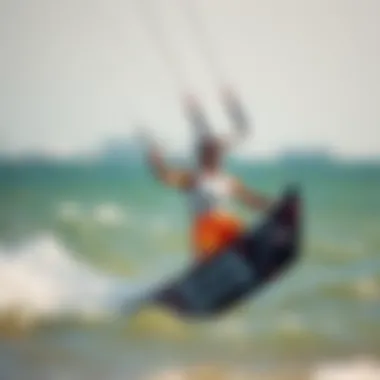
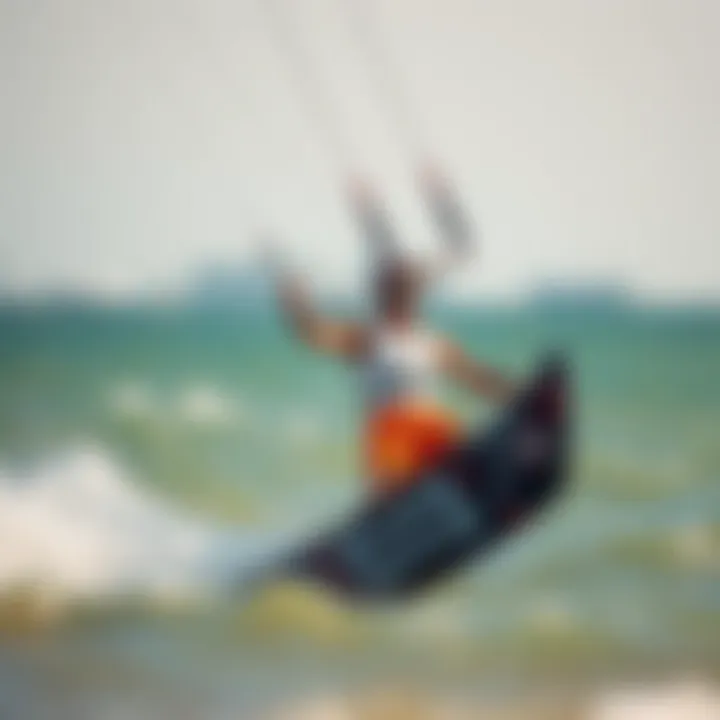
Intro
Kiteboarding on Lake Erie can be an exhilarating experience, yet it demands a profound understanding of the unique wave patterns and weather conditions that this vast body of water presents. Kiteboarders, whether novices or seasoned thrill-seekers, must navigate these ever-changing elements to harness the lake's potential while ensuring safety and enjoyment.
At the heart of this adventure lies wave forecasting—an essential practice that informs kiteboarders about when and where to hit the water. This guide will shed light on not just the nuances of wave forecasting but also equip kiteboarding enthusiasts with the necessary tools and techniques to make the most of their sessions.
Understanding the interplay of meteorological factors is crucial. Fluctuations in wind speed, temperature variations, and even local geographic features all contribute to Lake Erie's wave dynamics. Moreover, as technology advances, kiteboarders have a variety of tools at their disposal for accurate forecasting. With this knowledge, riders can align their skills with the optimal conditions, creating safer and exhilarating escapades on the water.
Let’s delve deeper into the essentials of kiteboarding gear, pivotal techniques, and invaluable tips for mastering the waves on Lake Erie.
Intro to Lake Erie Wave Dynamics
Understanding wave dynamics on Lake Erie is crucial for kiteboarders seeking to enjoy this vast body of water. The interplay between wind, water, and the unique geographic features of the lake creates conditions that are anything but mundane. Whether you're gliding across the surface or attempting to catch that perfect wave, recognizing how these components work together can significantly enhance your kiteboarding experience.
Overview of Lake Erie
Lake Erie is the fourth largest of the five Great Lakes by surface area, stretching approximately 241 miles with a maximum depth of about 210 feet. It’s bordered by the states of Ohio, Pennsylvania, and New York to the U.S. side, while Canada’s province of Ontario makes up its northern shore. Unlike its deeper counterparts, Lake Erie has a relatively shallow profile, which heavily influences its wave patterns and characteristics.
The lake’s shallowness means that it can warm quickly in the summer, leading to localized wind patterns and generating waves that can change rapidly. This is vital information for kiteboarders—knowing how the lake behaves can mean the difference between an excellent session and a difficult one. Additionally, the bustling towns around the lake, like Sandusky and Cleveland, create a vibrant culture around water sports, offering resources and community for enthusiasts.
Unique Characteristics of Lake Erie Waves
Waves on Lake Erie have some idiosyncratic traits that set them apart from other bodies of water.
- Fetch Limitations: Since Lake Erie isn’t exceedingly wide, wind-generated waves often experience fetch limitations. This means that the maximum height of waves can be considerably impacted by the duration and strength of the wind, factors that kiteboarders must learn to read.
- Wind Direction Sensitivity: Winds blowing across the lake from different directions can create varying wave conditions. Cross-shore winds may produce choppy waters while onshore winds often lead to more favorable and stable kiteboarding conditions.
- Seasonal Variability: The seasons change everything. In summer, the warm surface temperatures can create more enjoyable kiteboarding conditions, while in winter, ice formation can complicate things drastically. Knowing what time of year yields optimal waves can shape a boarder’s schedule dramatically.
"The waves might whisper their secrets to the keen listener, but without understanding them, a kiteboarder may find themselves navigating choppy waters with little reward."
In summary, grasping the dynamics of wave formation on Lake Erie is not just beneficial—it’s essential for keeping your kiteboarding sessions safe and enjoyable. Learning the nuances of wind patterns and their effects on the waves can be the deciding factor in mastering this extraordinary lake.
Understanding Wave Formation
Grasping the mechanics behind wave formation is key for kiteboarders looking to master the conditions on Lake Erie. Wave formation is influenced by a combination of wind patterns and geographic features, both of which significantly shape the experience one can expect on the water. Understanding these elements not just enhances one’s kiteboarding skills but also promotes safety and preparedness.
Influence of Wind Patterns
Wind is arguably the primary driving force behind wave creation. In simple terms, as wind blows across the surface of the lake, it transfers energy to the water, creating waves. Different wind conditions can result in varying wave heights and periods. For instance, sustained winds blowing from the west tend to create larger waves compared to a gentle breeze from the east.
Additionally, kiteboarders should pay attention to wind speed and direction when planning their sessions.
- Strong winds can lead to dangerously high waves, making the conditions unfavorable.
- Shifting wind patterns can also affect wave stability, causing the water to become choppy or unpredictable.
Monitoring local forecasts, especially during the spring and fall when winds may kick up unexpectedly, could prevent a bad experience on the water.
Role of Geographic Features
Lake Erie isn’t just a flat surface of water. Its geographic features play a crucial role in how waves are formed and how they behave. For example, shoreline contours, islands, and underwater topography can significantly influence wave formation. Areas where the lake is more shallow can lead to disorganized waves, while deeper sections offer a more uniform wave pattern.
Key geographic influences include:
- Land formations: These can act as windbreaks, causing waves to behave differently in various parts of the lake.
- Depth variations: In shallower areas, waves may break earlier and create choppy conditions, whereas deeper spots allow waves to develop more fully, creating better conditions for kiteboarding.
- Obstructions: Rocks or piers can disrupt wave flow, causing unpredictable conditions.
Wind patterns and geographic factors work in tandem to create the wave environment kiteboarders encounter. Being mindful of these elements not only helps in choosing the right time and place for kiteboarding but also enhances the overall experience. An awareness of local conditions and understanding how they influence wave patterns can make all the difference during a kiteboarding session on Lake Erie.
"Knowledge of environmental conditions is the key to a successful kiteboarding adventure."
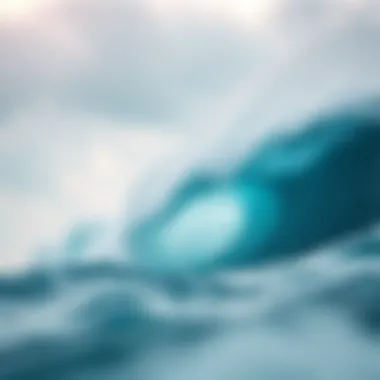
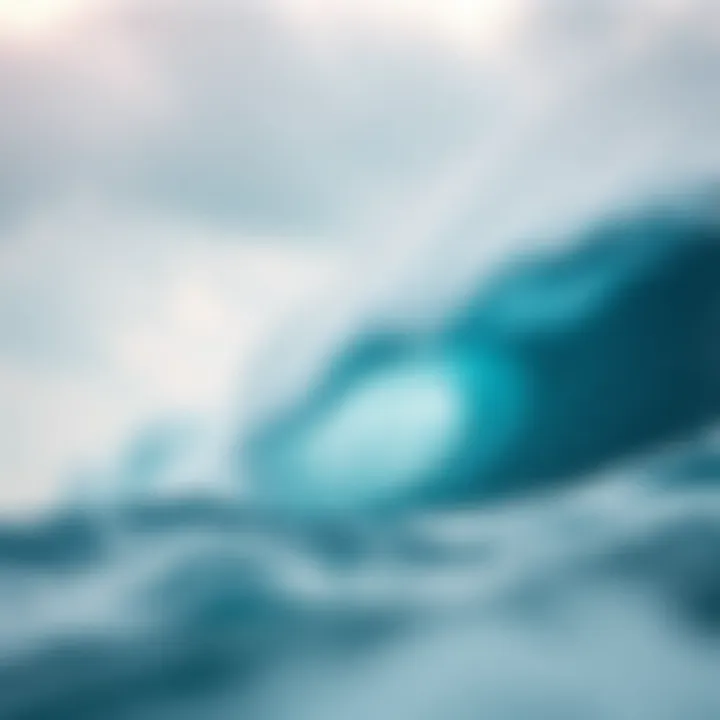
Familiarizing oneself with these elements gives kiteboarders an upper hand. It’s about reading the conditions accurately to ensure an enjoyable and safe time on the water.
Techniques for Accurate Wave Forecasting
When kiteboarders flock to the unique waters of Lake Erie, understanding the waves becomes not just a hobby, but a necessity. Accurate wave forecasting techniques play a pivotal role in ensuring safety and enhancing the enjoyment of this exhilarating sport. Knowledge of wave patterns allows kiteboarders to pick favorable times to hit the water, maximizing both performance and safety. This section breaks down three core techniques used in wave forecasting: analyzing meteorological data, utilizing wave models, and incorporating real-time observations.
Analyzing Meteorological Data
To grasp the pulse of Lake Erie's waves, kiteboarders must get familiar with meteorological data. This means diving deep into weather reports that include key indicators like wind speed, wind direction, and atmospheric pressure. Kiteboarding success is heavily reliant on the wind. For instance, a steady wind blowing directly across the lake can generate ideal wave conditions, while variable winds can lead to choppy waters.
A kiteboarder should regularly consult resources such as NOAA’s National Weather Service or local weather stations to get the most accurate data. Factors such as temperature trends and seasonal changes can also affect wave conditions. Understanding these metrics can alert a rider to the best times to launch their kite, which can lead to a much smoother experience.
Regularly monitoring meteorological data is essential for kiteboarders looking to optimize their time on the water.
Utilizing Wave Models
Wave models serve as a sophisticated tool for those looking to dive into the intricacies of wave dynamics. These models use mathematical equations to simulate wave formation and movement based on current meteorological data. For Lake Erie, relevant models like the Global Wave Model (GWM) leverage complex atmospherics to predict wave height and period. By checking these models, a kiteboarder can forecast how waves are likely to behave.
While these models provide a broad outlook, interpreting them requires some expertise. Coverage from sites like the European Centre for Medium-Range Weather Forecasts (ECMWF) or the Coastal Ocean modeling system can be invaluable. Moreover, the precision of wave height predictions can significantly influence decision-making, especially for intermediate to advanced kiteboarders eyeing those adrenaline-pumping sessions.
Incorporating Real-Time Observations
Real-time observations act as the icing on the cake. While forecasts give a look into the future, actual data provides the here-and-now context that kiteboarders need. Observations can come from local buoys scattered throughout Lake Erie, which provide vital information such as wave height and water temperature. Many kiteboarders also use community insights, sharing observations from peers who are out on the water.
Incorporating this immediate data turns predictions into actionable insights. Websites and mobile apps that feature live updates can guide kiteboarders on the ground, allowing them to make quick calls about heading out or postponing a session. This dynamic approach helps in navigating sudden storms or changes in the prevailing winds.
Local Weather Influences on Lake Erie Waves
Understanding local weather influences on Lake Erie’s wave patterns is crucial for kiteboarders seeking both safety and optimal riding conditions. Weather plays a significant role in shaping the waves, dictating everything from their height to frequency. Kiteboarders need to familiarize themselves with how local climatic conditions can lead to variations in wave behavior.
Seasonal Variations
The four seasons drastically shift the weather patterns across Lake Erie, and with them, the wave conditions that kiteboarders must navigate.
- Spring: As temperatures begin to rise, winds tend to become more variable. This time can produce sudden gusts as cold fronts collide with warm air from the land, creating choppy waters that can be challenging for novice kiteboarders.
- Summer: Typically offers consistent conditions. The prevailing summer winds, often from the southwest, can create ideal kiteboarding conditions. The waves are generally less chaotic, allowing for better control and more enjoyable riding experiences. However, one must remain cautious of thermal winds that can develop in the afternoons.
- Autumn: This season heralds a shift again, as storms start to develop more frequently. The increase in storm activity can produce powerful waves, presenting both a challenge and thrill to experienced riders. Seasonal shift can lead to unpredictable wind patterns, making forecasting essential.
- Winter: While kiteboarding in winter is less common due to frigid temperatures, those who dare can find unique wave setups. Ice formations and lower wind speeds can alter the wave dynamics considerably, calling for a different approach and gear for the brave few who continue to ride.
Impact of Storms and Fronts
Storms and cold fronts have a profound impact on wave conditions on Lake Erie. These weather events can ramp up wind speeds and alter wave characteristics rapidly. Here’s a deeper look at their effects:
- Storm Systems: When a storm passes through the region, waves can grow significantly in size due to heightened wind speeds. For kiteboarders, this can mean encountering larger surf that requires skill to navigate safely. Jumping on these conditions can offer thrilling rides and spectacular wave formations, but it does increase the risk factor.
- Cold Fronts: The arrival of a cold front often leads to a dramatic increase in wind, sometimes reaching up to 30 mph or more. This abrupt change can create steep, choppy waves that are not only exciting but also dangerous. Kiteboarders need to pay attention to local forecasts and be prepared to adjust their plans quickly.
- Pressure Systems: High-pressure systems generally bring calmness leading to cleaner wave patterns, making for great conditions. Conversely, low-pressure systems can contribute to more unsettled weather, heightening the chances of unexpected gusts.
The unpredictable nature of Lake Erie’s weather means that kiteboarders must remain vigilant and informed at all times. Staying updated on local forecasts can ensure safer and more enjoyable sessions.
How to Interpret Wave Forecasts
Wave forecasts are crucial for kiteboarders looking to make the most of their time on the water. Understanding how forecasts work can not only enhance your kiteboarding experience but also ensure your safety. Accurate interpretation helps riders avoid turbulent conditions and capitalize on optimal wave patterns. Here, we dive into key elements that form the backbone of these forecasts.
Understanding Forecast Metrics
When looking at wave forecast metrics, there are several parameters one should pay close attention to:
- Wave Height: This indicates the size of the waves, measured from the crest to the trough. For kiteboarding, most riders prefer waves between 1 to 4 feet, depending on their skill level and equipment.
- Wave Period: This is the time it takes for consecutive waves to pass a fixed point. A longer wave period generally leads to more organized and powerful waves, which can enhance your riding experience.
- Wind Speed and Direction: Wind plays a significant role in wave formation. Understanding the forecasted wind speed and direction can tell you if the water will be choppy or smooth. For kiteboarders, offshore winds often create better conditions compared to onshore winds.
- Tidal Effects: Tides can affect wave size and shape, especially around coastal areas. Make sure to check forecasts that include tidal movements, as this can change conditions quickly.
Interpreting these metrics can seem daunting at first, especially for novices. Still, with experience, you’ll start to recognize patterns and how different factors interlink. It's like learning a new language, where every term represents a vital element of the environment you’re about to navigate.
Remember: When you're on the water, conditions can change rapidly. Always stay informed and keep an eye on updates to ensure your safety and enhance your kiteboarding experience.
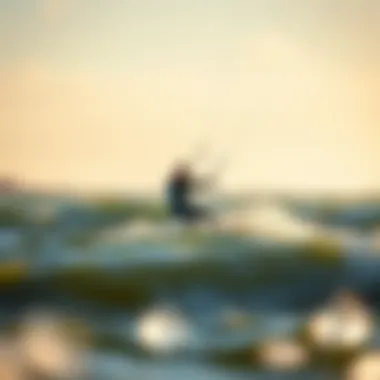
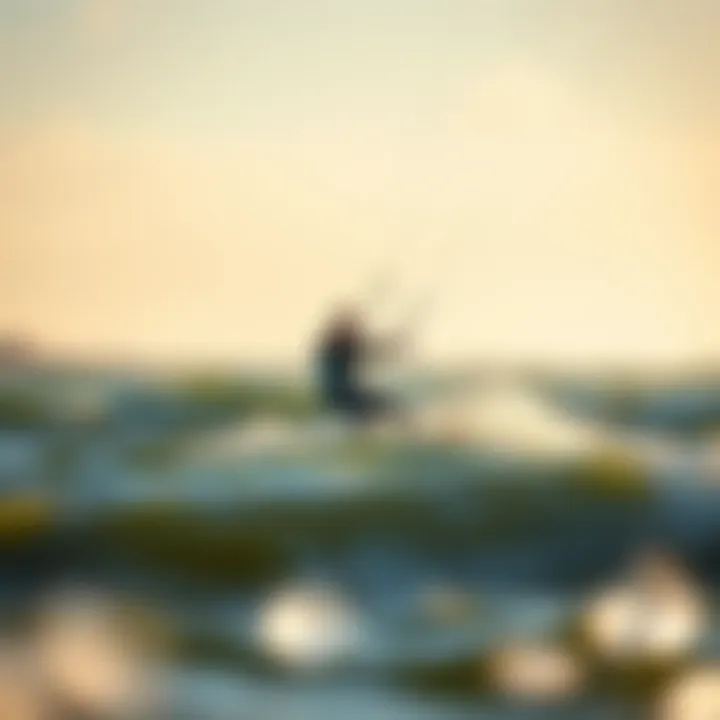
Identifying Optimal Conditions for Kiteboarding
Optimal kiteboarding conditions often align with certain weather and wave scenarios. Here's how to spot them effectively:
- Ideal Wave Height: As mentioned, look for waves in the 1 to 4 feet range. But also consider your skill level. Beginners might prefer smaller waves, while experienced kiteboarders thrive in larger swells.
- Wind Conditions: The sweet spot for kiteboarding is usually a wind speed between 12 to 25 knots. Less than this can lead to a lackluster session, while too much can pose dangers. Check reliable sources for local wind forecasts.
- Weather Stability: A forecast with stable weather patterns often indicates good riding conditions. After a storm, conditions may be unpredictable, so give nature time to settle.
- Time of Day: Early morning or late afternoon often offer gentle winds and manageable waves. Spotting these windows helps you plan your sessions effectively.
- Weather Apps and Local Reports: Utilize kiteboarding-specific apps and local reports that offer insights tailored to kiteboarders. Websites such as Windy and KiteMap can provide real-time updates and advisories.
Ultimately, knowing how to interpret these forecast elements empowers kiteboarders to make informed decisions. This understanding can lead to a more fulfilling experience on Lake Erie, one where you feel adventurous and carefree.
Safety Considerations for Kiteboarding on Lake Erie
Kiteboarding on Lake Erie can offer exhilarating experiences, but safety must be at the forefront of every kiteboarder's mind. Understanding the risks and making informed decisions about weather conditions and potential hazards can make the difference between a thrilling adventure and a dangerous situation. Before taking to the water, it’s essential to assess the conditions thoroughly and consider the unique challenges Lake Erie presents.
Assessing Conditions Before Boarding
Before jumping on your board, take a moment to evaluate the water and weather conditions. This isn't just about ensuring a good ride; it's about your safety and well-being. Start by looking at the following factors:
- Wind Speed and Direction: Check the forecast for the wind speed and direction. Ideal conditions usually feature steady winds that are neither too light nor too strong. Too strong can lead to unpredictable conditions while too weak can leave you stranded.
- Water Level and Tides: Be aware of the current water levels and any tidal movements. Lake Erie doesn't have a traditional tide like the ocean, but it does experience fluctuations that can change the conditions quickly.
- Temperature: Monitor the air and water temperatures to ensure you wear appropriate gear. Water temperatures can drop rapidly, especially in the spring or fall, increasing the risk of hypothermia if you're not properly attired.
- Visibility: Fog and rain can reduce visibility, making it difficult to spot hazards or other water users. Always err on the side of caution when conditions are not clear.
If you have doubts about the conditions, it may be better to sit it out until they improve. Remember, safety comes first.
Avoiding Hazards Specific to Lake Erie
Navigating the waters of Lake Erie isn't without its hazards. By avoiding known risks, kiteboarders can focus more on enjoying their time on the water. Here are some hazards to be particularly mindful of:
- Debris and Obstructions: Natural debris from storms or heavy winds can litter the water. Fallen trees, driftwood, or rocks can easily cause accidents.
- Changing Weather: Lake Erie is known for its rapidly changing weather. A nice sunny day can turn stormy in minutes, so keep an eye on any incoming weather systems.
- Boat Traffic: Be aware of the vessel traffic on the lake. Other watercraft can pose a risk, especially if they are moving quickly and not paying close attention to kiteboarders.
- Shoreline Changes: Erosion and shifting sandbars can alter familiar shorelines, leading to unexpected dangers. Always scout your launch and landing zones before each session.
Safety should never be taken lightly when kiteboarding. The combination of wind, water, and unpredictable elements can create dangerous scenarios. Equip yourself with knowledge and respect the elements to ensure a fun and safe kiteboarding experience.
Keeping these considerations in mind will greatly enhance not only your kiteboarding sessions but also your overall experience on Lake Erie. The lake's beauty and challenges can be enjoyed to the fullest when you prioritize safe practices.
Best Times for Kiteboarding Based on Wave Forecasts
The art of kiteboarding on Lake Erie is as much about timing as it is about skill. Understanding when the waves are at their peak is crucial for both safety and enjoyment. Kiteboarders need to consider various factors that can dictate the ideal moments to hit the water. Knowing these times not only enhances your ride but can also prevent dangerous situations. With this in mind, let’s explore how kiteboarders can effectively determine the best times based on wave forecasts.
Timing Your Sessions
When planning kiteboarding sessions, the timing can make or break your experience on Lake Erie. Kiteboarders should prioritize the hours just after weather systems have cleared. During these times, one might find that the wind is more consistent, leading to steadier waves that create a more enjoyable ride.
Moreover, it is essential to keep an eye on the typical wind patterns around the lake. For instance, winds that blow steadily from the west can build up impressive waves, whereas sudden gusts might create unpredictable conditions.
Here’s a simple checklist to consider for timing your sessions:
- Check weather forecasts: Wind speed above 15 knots is generally desirable.
- Observe cloud formations: Clearing skies typically indicate stronger winds.
- Monitor local kiteboarding groups for insights on current conditions.
Utilizing Tidal and Weather Patterns
Wind isn’t the only player in the game; tides and broader weather patterns also significantly influence wave conditions. Kiteboarders should familiarize themselves with the tide charts of Lake Erie, as tides can affect wave size and strength depending on the time of day. During high tide, waves can be fuller and provide a more exhilarating experience.
Key tidal influences include:
- High Tide: Often produces larger, more powerful waves conducive for advanced maneuvers.
- Low Tide: May lead to choppy conditions, ideal for beginners looking to practice without the higher stakes of big waves.
In addition to tides, keep a watchful eye on the overall weather patterns. Cold fronts, for example, can stir up strong winds, leading to higher, choppier waves that can excite experienced kiteboarders. However, these conditions may be less forgiving for those who are new to the sport.
"Choosing the right time to kiteboard can be like catching lightning in a bottle; when conditions align, you can experience pure magic on the water."
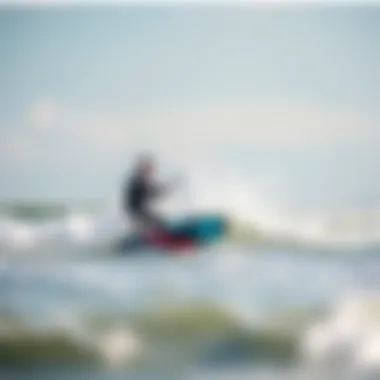
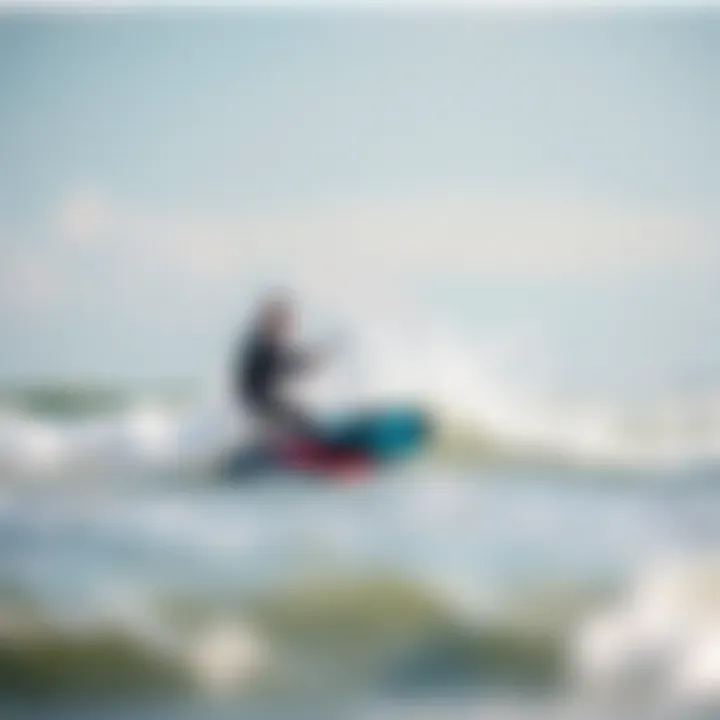
By blending knowledge of wave forecasts with a keen understanding of the wind and tides, kiteboarders can significantly improve their overall experience on Lake Erie. It’s about maximizing fun while keeping safety at the forefront. Planning ahead and being adaptable to changing conditions will ensure each session is memorable.
Advanced Forecasting Technologies and Tools
The wave forecasting landscape has evolved significantly, providing kiteboarders with tools that can drastically improve their on-water experience. Understanding the operational mechanics behind these technologies is central to making informed decisions, whether one is planning a spontaneous kiteboarding session or aiming for an all-day adventure.
By incorporating advanced technologies, kiteboarders can gain insights into conditions that are crucial for safe and exhilarating experiences on Lake Erie. With access to accurate forecasts, enthusiasts can better align their kiteboarding schedules with the prime conditions and reduce the risks commonly associated with lake activities.
Apps and Websites for Kiteboarders
A variety of applications and websites specifically tailored for kiteboarding communities have sprung up. Here are some key options:
- Windy.com: This app provides real-time weather data, including wind speeds and directions, which are vital for kiteboarding. The detailed maps offer a granular look at local conditions.
- KiteMap: A community-driven site that not only shares forecasting tools but also outlines popular kiteboarding spots around Lake Erie. Users can contribute their local insights to foster a shared knowledge base.
- Magicseaweed: Known predominantly for surfers, this platform also offers relevant information for kiteboarders, providing reliable surf forecasts that can correlate with potential wave conditions.
- Buoyweather: This service is focused on marine weather forecasts. It includes wind speed and wave height predictions, essential for deciding when to hit the water.
Besides these resources, social platforms like Facebook groups and Reddit communities can also offer real-time updates and personal testimonies on kiteboarding conditions from local enthusiasts.
"Using these tools can feel like having the weather at your fingertips; it's all about knowing when to seize the day."
Understanding Wave Forecast Technology
Wave forecast technology relies on complex algorithms that synthesize a multitude of data points to produce reliable predictions. There are several layers to this technology:
- Numerical Weather Prediction (NWP): This involves numerical models that simulate the atmosphere's behavior based on current conditions. These models rely on data from satellites, buoys, and ground stations, thereby creating accurate forecasts that reflect real-time changes.
- Wave Models: These models integrate wind forecasts to predict wave generation and propagation. They can estimate wave height, direction, and period, which are critical factors for kiteboarders.
- Real-Time Data Integration: Some advanced systems include real-time wave observations, adjusting predictions based on current conditions. This adaptability can be invaluable, especially with unpredictable weather patterns.
Understanding these mechanisms can help kiteboarders discern not just the numbers, but the underlying factors that contribute to those forecasts. This knowledge enhances one's ability to respond nimbly to changing conditions, ensuring a higher degree of safety and fun during kiteboarding experiences.
Community Insights on Lake Erie Kiteboarding
Community plays a vital role in the kiteboarding experience on Lake Erie. The camaraderie among kiteboarders, shared knowledge, and resources make for a rich environment that fosters both skill development and safety on the water. This section delves into the importance of connecting with fellow enthusiasts, recognizing local organizations, and extracting valuable insights that can elevate one’s kiteboarding adventures.
Local Kiteboarding Groups and Resources
Engaging with local kiteboarding groups offers a myriad of benefits. Firstly, these communities serve as hubs for information sharing. Many kiteboarders flock to social media platforms or forums like Reddit or specific Facebook groups to keep each other updated on kite conditions, equipment tips, or even local events.
Moreover, finding local kiteboarding schools or clubs provides not only lessons but also access to equipment rentals and group outings. These activities deepen the bonds within the community and reinforce the passion for the sport. For instance, groups such as the Lake Erie Kiteboarding Association provide a platform for discussion as well as collaboration on organizing meetups or competition events. Joining such an organization could also expose beginners to seasoned riders, who are often eager to share their experiences.
It's also worth mentioning that local kiteboarders are usually quite knowledgeable about the specific conditions on Lake Erie and can offer insights on the best spots to catch waves or learning opportunities tailored to each skill level.
Sharing Knowledge and Experiences
A significant advantage of community involvement lies in the sharing of individual experiences and practical knowledge regarding kiteboarding on Lake Erie. Kiteboarders often recount stories of challenges and triumphs they’ve encountered while navigating the lake’s dynamic waters. These anecdotes not only provide entertainment but also serve as lessons for others.
"Every session on Lake Erie is different. Listening to others' tales can prepare you for what lies ahead—be it a rogue wave, shifting winds, or unexpected weather changes."
In addition, these exchanges often include advice on gear selection, maintenance, and upgrades. For instance, discussing the best kites for specific wind conditions can be invaluable for someone looking to purchase their first kite. Likewise, local legends or popular spots for kiteboarding can come alive through shared tales, ensuring that newcomers do not feel lost in a new environment.
Frequency of community gatherings, such as free clinics or demo days, also create opportunities for practical learning. They promote a sense of kinship among kiteboarders, enhancing the overall enjoyment and safety of the sport.
End: Embracing the Lake Erie Experience
Engaging with the waters of Lake Erie is not just about kiteboarding; it’s about immersing oneself in a vibrant ecosystem shaped by diverse weather patterns, geographic nuances, and a dedicated community. This article has painted a clearer picture of how various factors interplay to create conditions optimal for kiteboarding. For anyone looking to make the most of their time on the water, grasping these dynamics can mean the difference between a mediocre session and an unforgettable adventure.
One of the critical elements discussed throughout the article is the importance of understanding wave forecasting. Kiteboarders need to read and interpret wave conditions to ensure safety and maximize enjoyment. Having a solid grasp of forecasting methods allows enthusiasts to choose their session times astutely. By navigating the intricacies of meteorological data, real-time observations, and seasonal variations, kiteboarders can effectively plan their outings around the patterns that Lake Erie offers.
Moreover, embracing the Lake Erie experience involves recognizing the community and the resources available. Local kiteboarding groups provide not only camaraderie and shared experiences but also wisdom accumulated over years of observing the lake. Sharing knowledge about specific spots, safety tips, and environmental concerns enhances not only individual experiences but builds a stronger kiteboarding community. When we work together, we ensure that everyone can enjoy the lake in a safe and responsible manner.
Looking Forward to Kiteboarding Adventures
As the winds shift and the seasons change, anticipation hangs in the air for kiteboarders across the shorelines of Lake Erie. There’s a certain exuberance that comes with planning your next kiteboarding session, especially when considering the combination of ideal wave conditions and favorable weather. This section encourages you to look ahead, to be proactive in your kiteboarding endeavors.
- Stay Informed: Keep regularly updated on forecasts using reliable apps or websites tailored to kiteboarding. Websites like Windy (windy.com) and local meteorological services offer details that can help you gauge conditions accurately.
- Connect with Locals: Veteran riders have an innate sense of the lake's conditions. Participating in local kiteboarding forums on platforms like Reddit or Facebook groups can yield insider knowledge that forecasts alone might miss.
- Plan Your Sessions: Look for consistent winds and manageable wave heights that suit your skill level. Knowing the best locations based on seasonal patterns can help you plan successful outings.
- Join Events: Participating in local kiteboarding events not only builds skills but also strengthens community ties. Whether it's races or informal gatherings, these occasions can lead to wonderful discoveries of new spots and new friends.
Embracing the thrill of kiteboarding on Lake Erie means adjusting to its rhythms, learning the subtleties of its waves, and understanding the winds. Every session holds the potential for adventure; with knowledge and community support, each outing can lead to personal growth and skill enhancement.















